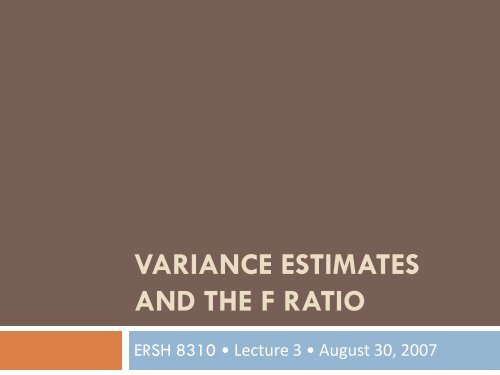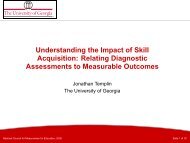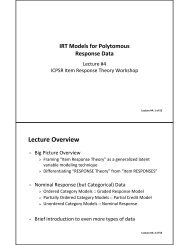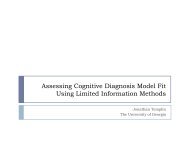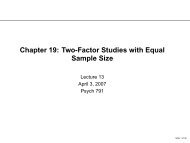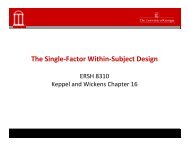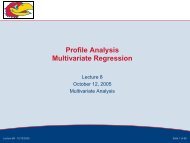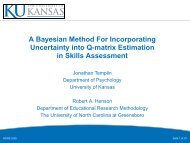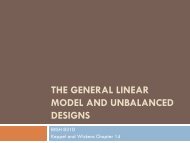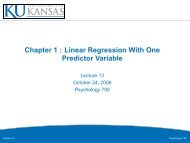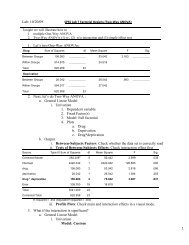Variance Estimates and the F Ratio
Variance Estimates and the F Ratio
Variance Estimates and the F Ratio
Create successful ePaper yourself
Turn your PDF publications into a flip-book with our unique Google optimized e-Paper software.
VARIANCE ESTIMATES<br />
AND THE F RATIO<br />
ERSH 8310 • Lecture 3 • August 30, 2007
Today’s Class<br />
Completing <strong>the</strong> analysis (<strong>the</strong> ANOVA table).<br />
Evaluating <strong>the</strong> F ratio.<br />
Errors in hypo<strong>the</strong>sis testing.<br />
A complete numerical example.
Completing <strong>the</strong> Analysis<br />
The ANOVA Table
Completing <strong>the</strong> Analysis<br />
<br />
Table 3-1 presents a summary table of <strong>the</strong> analysis of<br />
variance that contains entries of <strong>the</strong> source, <strong>the</strong> basic ratio,<br />
<strong>the</strong> sum of squares, <strong>the</strong> degree of freedom, <strong>the</strong> mean<br />
squares, <strong>and</strong> <strong>the</strong> F value.<br />
<br />
Note that variance is SS/df.
Degrees of Freedom<br />
The degree of freedom, df, associated with a sum of<br />
squares corresponds to <strong>the</strong> number of scores with<br />
independent information that enter into <strong>the</strong> calculation<br />
of <strong>the</strong> sum of squares.<br />
The general rule for computing <strong>the</strong> df of any sum of<br />
square is<br />
df = (number of independent observations) -(number of<br />
restraints)<br />
or<br />
df = (number of independent observation) -(number of<br />
population estimates).
Degrees of Freedom<br />
Note that df T = df A + df S/A <strong>and</strong> (a)(n)-1 = (a-<br />
1)+a(n-1).<br />
For example, for data in Table 2-2, SS T has df T =<br />
df A +df S/A = (3-1)+3(5-1) = 14 given <strong>the</strong> estimate<br />
of <strong>the</strong> population mean is [Y] = 10 <strong>and</strong>,<br />
consequently, <strong>the</strong>re is one constraint.
Mean Squares<br />
The mean squares are given by: MS = SS/df.<br />
So far, we have two mean squares:<br />
MS<br />
A<br />
SS<br />
df<br />
A<br />
A<br />
MS<br />
S / A<br />
SS<br />
df<br />
S / A<br />
S / A
Confidence Intervals for Treatment<br />
Means<br />
The confidence interval for a population mean is given<br />
by <strong>the</strong> formula:<br />
Where<br />
Y j<br />
Y<br />
j<br />
t<br />
s<br />
M<br />
j M j<br />
is <strong>the</strong> mean of <strong>the</strong> treatment group<br />
t is a critical value with <strong>the</strong> degrees of freedom of n j -1<br />
s Mj is <strong>the</strong> estimated st<strong>and</strong>ard error of <strong>the</strong> mean or<br />
s j /√n j .<br />
For <strong>the</strong> pooled estimate, <strong>the</strong> degrees of freedom will<br />
be a(n-1) <strong>and</strong> s M will be √{MS S/A /n j }.<br />
Y<br />
j<br />
t<br />
s
The F <strong>Ratio</strong><br />
The formula of <strong>the</strong> F ratio is F = MS A / MS S/A<br />
The degrees of freedom are:<br />
df A = df 1 = a-1<br />
df S/A = df 2 = a(n-1).<br />
The F ratio is approximately 1.0 when <strong>the</strong> null<br />
hypo<strong>the</strong>sis is true <strong>and</strong> is greater than 1.0 when <strong>the</strong><br />
null hypo<strong>the</strong>sis is false.
Evaluating <strong>the</strong> F <strong>Ratio</strong>
The Sampling Distribution of F<br />
A frequency distribution of a statistic (e.g., F) is called a<br />
sampling distribution of <strong>the</strong> statistic.<br />
Suppose that for an experiment a = 3, n = 5 (or N =<br />
15), <strong>and</strong> <strong>the</strong> null hypo<strong>the</strong>sis is true so that μ 1 = μ 2 =<br />
μ 3 .<br />
Assume that we draw a very large number of such<br />
experiments each consisting of three groups of 5 scores,<br />
<strong>and</strong> that we compute <strong>the</strong> value of F for each case.<br />
We can construct a graph relating F <strong>and</strong> frequency of<br />
occurrence [see Figure 3-1 for F(2,12)].
The F Table<br />
The exact shape of <strong>the</strong> F distribution is determined<br />
by <strong>the</strong> number of df's associated with <strong>the</strong> numerator<br />
<strong>and</strong> denominator mean squares in <strong>the</strong> F ratio.<br />
We will use F(df num. , df denom. ) or F df1,df2 .<br />
An F table is found in Appendix A.1 (see pp. 571-<br />
575).
Using <strong>the</strong> F Table<br />
A particular value of F in this table is specified by<br />
three factors:<br />
(1) <strong>the</strong> numerator df<br />
(2) <strong>the</strong> denominator df<br />
(3) <strong>the</strong> value of α<br />
• Where α refers to <strong>the</strong> proportion of area to <strong>the</strong> right of an<br />
ordinate drawn at F a .<br />
• The α levels, α = .10, .05, .025, .01, <strong>and</strong> .001, are ones<br />
most commonly encountered, <strong>and</strong> <strong>the</strong>se are listed in <strong>the</strong><br />
table.
The Distribution of F When <strong>the</strong> Null<br />
Hypo<strong>the</strong>sis Is False<br />
The <strong>the</strong>oretical distribution when H 0 is false is called<br />
<strong>the</strong> noncentral F (i.e., F ’ ) distribution.
Testing <strong>the</strong> Null Hypo<strong>the</strong>sis<br />
The two hypo<strong>the</strong>ses are:<br />
H 0 : μ 1 = μ 2 = μ 3 .<br />
H 1 : not all μ’s are equal.<br />
Assume that we have conducted an experiment <strong>and</strong> that<br />
we have computed <strong>the</strong> value of F.<br />
Suppose we could agree on a dividing line for any F<br />
distribution, where values of F falling above <strong>the</strong> line are<br />
considered to be unlikely (i.e., incompatible with H 0 )<br />
<strong>and</strong> values of F falling below <strong>the</strong> line as considered to<br />
be likely (i.e., compatible with H 0 ).
Decision Rules<br />
One decision rule is to reject <strong>the</strong> null hypo<strong>the</strong>sis<br />
when <strong>the</strong> observed F falls within <strong>the</strong> region of<br />
incompatibility.<br />
In practice, <strong>the</strong>re is fairly common agreement on a<br />
probability of α = .05 to define <strong>the</strong> region of<br />
incompatibility for <strong>the</strong> F distribution.
Decision Rules<br />
This probability may be called <strong>the</strong> significance level. The rejection rule is:<br />
Reject H 0 when F observed ≥ F (α) (df num. ,df denom. );<br />
retain H 0 o<strong>the</strong>rwise.<br />
<br />
<br />
<br />
<br />
<br />
A researcher sometimes reports that an F is significant at <strong>the</strong> one percent level of<br />
significance.<br />
Occasionally a researcher reports <strong>the</strong> exact probability of F observed , a value that is<br />
provided automatically by most statistical computer programs.<br />
The exact probability refers to <strong>the</strong> proportion of <strong>the</strong> sampling distribution of <strong>the</strong> F<br />
statistic fall at or above (i.e., more extreme) <strong>the</strong> F found in an experiment.<br />
We do not need to consult an F table to determine significance, but instead we<br />
simply compare <strong>the</strong> exact probability with <strong>the</strong> chosen significance level <strong>and</strong> reject<br />
H 0 if <strong>the</strong> exact probability is smaller than <strong>the</strong> chosen significance level.<br />
For example, provided that α= .05, reject H 0 if p ≤.05 <strong>and</strong> retain H 0 o<strong>the</strong>rwise.
Avoiding Common Misuses of<br />
Hypo<strong>the</strong>sis Testing (p. 45-46)<br />
Never lose site of your data.<br />
Remember that not all null hypo<strong>the</strong>ses represent<br />
interesting or plausible outcomes of <strong>the</strong> experiment <strong>and</strong><br />
that <strong>the</strong>ir rejection is not inevitably informative.<br />
Remember that <strong>the</strong> null-hypo<strong>the</strong>sis test only gives<br />
information about how likely <strong>the</strong> sampling operations<br />
are to have produced your effect.<br />
When you find a significant effect, ask what it means.<br />
Always interpret your results in <strong>the</strong> context of o<strong>the</strong>r<br />
studies in <strong>the</strong> field.
Errors in Hypo<strong>the</strong>sis Testing
Errors in Hypo<strong>the</strong>sis Testing<br />
If we reject H 0 when it is true, <strong>the</strong>n we make <strong>the</strong><br />
type I error.<br />
If we retain H 0 when it is false, <strong>the</strong>n we make <strong>the</strong><br />
type II error.<br />
Note that α is <strong>the</strong> probability of type I error, <strong>and</strong><br />
that β is <strong>the</strong> probability of type II error (see Table<br />
3-3 on page 47).<br />
Power refers to <strong>the</strong> probability of rejecting <strong>the</strong> null<br />
hypo<strong>the</strong>sis when an alternative hypo<strong>the</strong>sis is true<br />
(i.e., power = 1- β).
A Complete Numerical Example
Vigilance Task While Sleep Deprived<br />
There are a = 4<br />
conditions, namely, 4, 12,<br />
20, <strong>and</strong> 28 hours without<br />
sleep.<br />
There are n = 4 subjects<br />
r<strong>and</strong>omly assigned to<br />
each of <strong>the</strong> different<br />
treatment conditions.<br />
The vigilance task score<br />
represents <strong>the</strong> number of<br />
failures to spot objects on<br />
a radar screen during a<br />
30-minute test period.
Data (computation p. 51)<br />
Hours without sleep<br />
4 hr 12 hr 20 hr 28 hr<br />
a 1 a 2 a 3 A 4<br />
37 36 43 76<br />
22 45 75 66<br />
22 47 66 43<br />
25 23 46 62
Final Thought<br />
<br />
<br />
The F-<strong>Ratio</strong> is <strong>the</strong> vehicle to test<br />
<strong>the</strong> null hypo<strong>the</strong>sis (es) of <strong>the</strong><br />
experiment.<br />
The F-<strong>Ratio</strong> is composed of two<br />
variances: between groups <strong>and</strong><br />
within groups.<br />
<br />
<br />
The ratio follows <strong>the</strong> idea of variance partitioning that will be<br />
present throughout <strong>the</strong> class.<br />
Don’t get too wrapped up into <strong>the</strong> formulae presented today:<br />
most every calculation will be done using a computer.
Next Class<br />
SPSS Introduction


